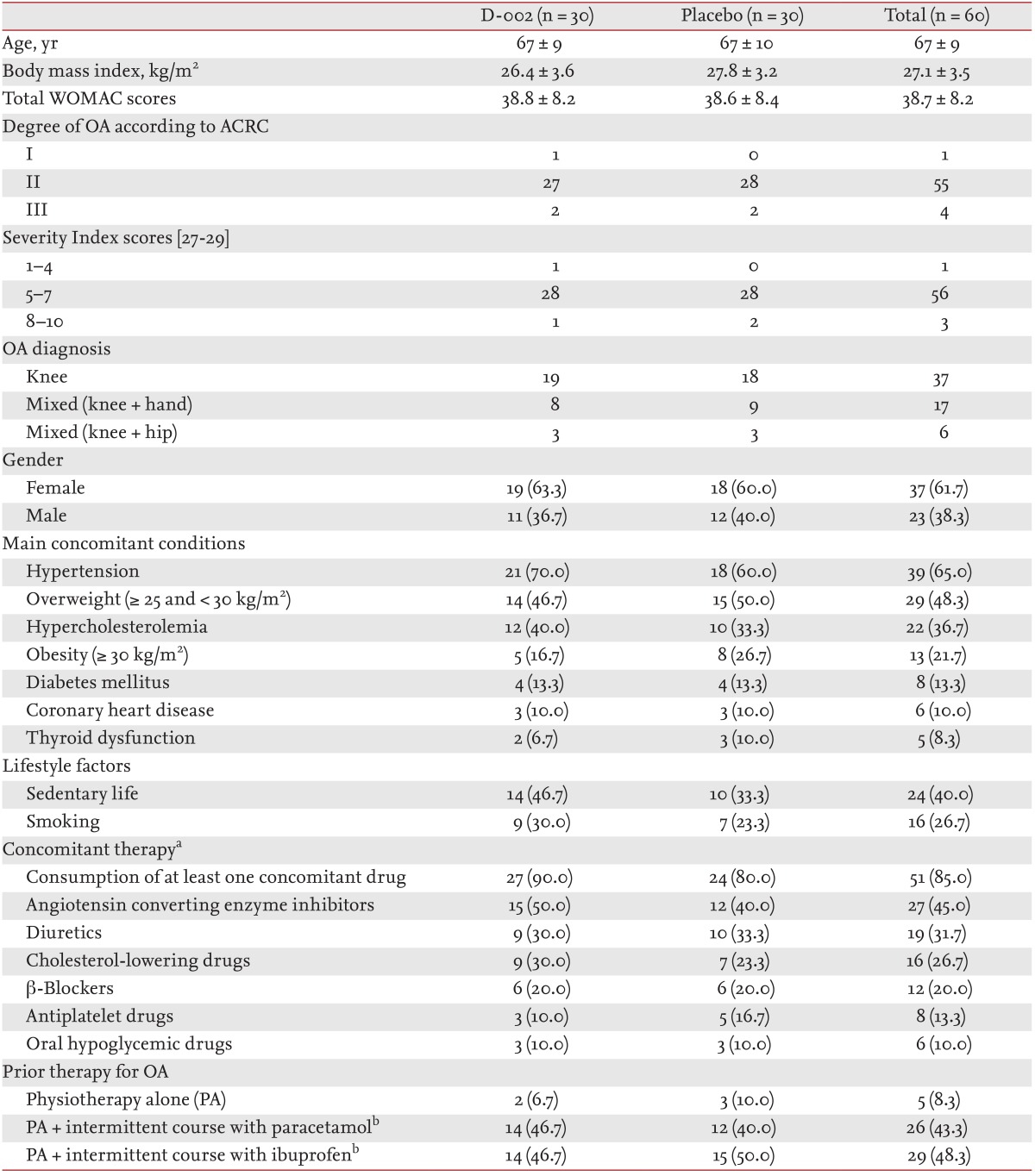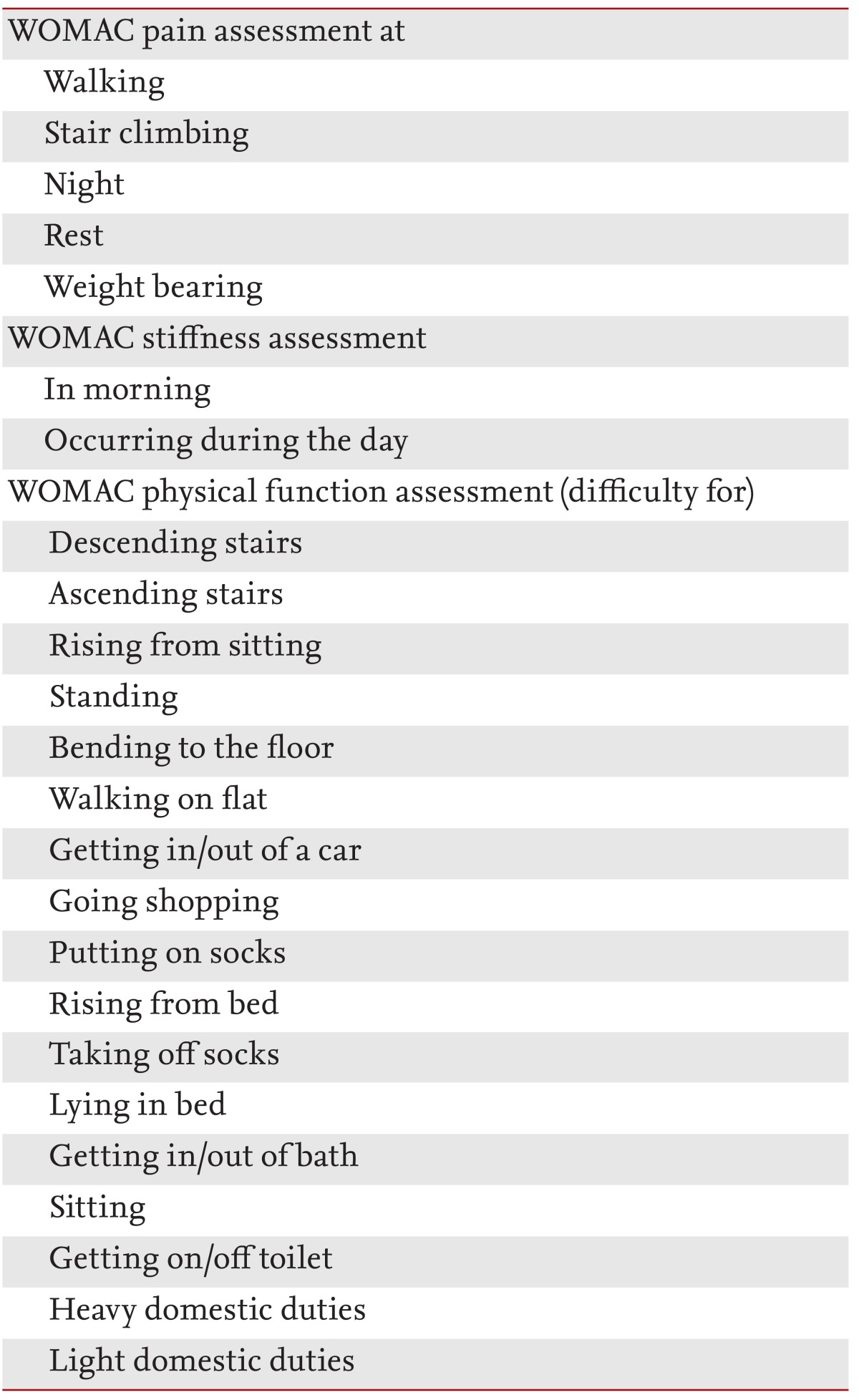1. Lozada C, Steigelfest E. Osteoarthritis. Med Rheumatol 2010;15:12ŌĆō23.
2. Iagnocco A, Naredo E. Osteoarthritis: research update and clinical applications. Rheumatology (Oxford) 2012;51(Suppl 7):vii2ŌĆōvii5PMID : 23230089.


4. Lee YC, Shmerling RH. The benefit of nonpharmacologic therapy to treat symptomatic osteoarthritis. Curr Rheumatol Rep 2008;10:5ŌĆō10PMID : 18457605.


6. Zhang W, Moskowitz RW, Nuki G, et al. OARSI recommendations for the management of hip and knee osteoarthritis, part I: critical appraisal of existing treatment guidelines and systematic review of current research evidence. Osteoarthritis Cartilage 2007;15:981ŌĆō1000PMID : 17719803.


8. Cherubino P, Sarzi-Puttini P, Zuccaro SM, Labianca R. The management of chronic pain in important patient subgroups. Clin Drug Investig 2012;32(Suppl 1):35ŌĆō44.

9. McCarberg B, Tenzer P. Complexities in the pharmacologic management of osteoarthritis pain. Curr Med Res Opin 2013;29:539ŌĆō548PMID : 23489409.


10. Merashly M, Uthman I. Management of knee osteoarthritis: an evidence-based review of treatment options. J Med Liban 2012;60:237ŌĆō242PMID : 23461090.

11. Mas R. D-002: antiulcer, antioxidant, antiinflammatory. Drugs Future 2001;26:731ŌĆō744.

12. Leone S, Ottani A, Bertolini A. Dual acting anti-inflammatory drugs. Curr Top Med Chem 2007;7:265ŌĆō275PMID : 17305569.


13. Carbajal D, Molina V, Valdes S, Arruzazabala ML, Mas R, Magraner J. Anti-inflammatory activity of D-002: an active product isolated from beeswax. Prostaglandins Leukot Essent Fatty Acids 1998;59:235ŌĆō238PMID : 9849648.


14. Ravelo Y, Molina V, Carbajal D, et al. Evaluation of anti-inflammatory and antinociceptive effects of D-002 (beeswax alcohols). J Nat Med 2011;65:330ŌĆō335PMID : 21258868.


15. Mendoza S, Noa M, Valle M, Mendoza N, Mas R. Ameliorating effects of D-002, a mixture of beeswax alcohols, on monosodium iodoacetate-induced osteoarthritis in rats. Int J Pharm Sci Rev Res 2013;19:10ŌĆō15.
16. Rodriguez I, Mendoza S, Illnait J, et al. Effects of D-002, a mixture of beeswax alcohols, on osteoarthritis symptoms: a randomized placebo-controlled study. IOSR J Pharm 2012;2:1ŌĆō9.

17. Altman R, Asch E, Bloch D, et al. Diagnostic and Therapeutic Criteria Committee of the American Rheumatism Association. Development of criteria for the classification and reporting of osteoarthritis: classification of osteoarthritis of the knee. Arthritis Rheum 1986;29:1039ŌĆō1049PMID : 3741515.


18. Altman R, Alarcon G, Appelrouth D, et al. The American College of Rheumatology criteria for the classification and reporting of osteoarthritis of the hip. Arthritis Rheum 1991;34:505ŌĆō514PMID : 2025304.


19. Batlle-Gualda E, Esteve-Vives J, Piera MC, Hargreaves R, Cutts J. Adaptacion transcultural del cuestionario WOMAC especifico para artrosis de rodilla y cadera. Rev Esp Reumatol 1999;26:38ŌĆō45.
20. Angst T, Aeschlimann A, Stucki G. Smallest detectable and minimal clinically important differences of rehabilitation intervention with their implications for required simple sizes using WOMAC and SF-36 quality of life measurement instruments in patients with osteoarthritis of the lower extremities. Arthritis Rheum 2001;45:384ŌĆō391PMID : 11501727.


21. Jinks C, Jordan K, Croft P. Measuring the population impact of knee pain and disability with the Western Ontario and McMaster Universities Osteoarthritis Index (WOMAC). Pain 2002;100:55ŌĆō64PMID : 12435459.


22. Salaffi F, Leardini G, Canesi B, et al. Reliability and validity of the Western Ontario and McMaster Universities (WOMAC) Osteoarthritis Index in Italian patients with osteoarthritis of the knee. Osteoarthritis Cartilage 2003;11:551ŌĆō560PMID : 12880577.


23. Gonzalez VL, Marrero D, Sierra R, Velazquez C, Vicente R. Nuevo metodo por Cromatografia Gaseosa Capilar para el analisis del ingrediente activo D002. Rev CENIC Cienc Quim 2008;39:123ŌĆō124.
24. Gruenwald J, Petzold E, Busch R, Petzold HP, Graubaum HJ. Effect of glucosamine sulfate with or without omega-3 fatty acids in patients with osteoarthritis. Adv Ther 2009;26:858ŌĆō871PMID : 19756416.


26. Naranjo CA, Busto U, Sellers EM, et al. A method for estimating the probability of adverse drug reactions. Clin Pharmacol Ther 1981;30:239ŌĆō245PMID : 7249508.


27. Lequesne MG, Mery C, Samson M, Gerard P. Indexes of severity for osteoarthritis of the hip and knee. Validation: value in comparison with other assessment tests. Scand J Rheumatol Suppl 1987;65:85ŌĆō89PMID : 3479839.


28. Lequesne M. Indices of severity and disease activity for osteoarthritis. Semin Arthritis Rheum 1991;20(6 Suppl 2):48ŌĆō54PMID : 1866630.


29. Lequesne MG. The algofunctional indices for hip and knee osteoarthritis. J Rheumatol 1997;24:779ŌĆō781PMID : 9101517.

30. Srikanth VK, Fryer JL, Zhai G, Winzenberg TM, Hosmer D, Jones G. A meta-analysis of sex differences prevalence, incidence and severity of osteoarthritis. Osteoarthritis Cartilage 2005;13:769ŌĆō781PMID : 15978850.


31. Rizzoli R, Boonen S, Brandi ML, et al. Vitamin D supplementation in elderly or postmenopausal women: a 2013 update of the 2008 recommendations from the European Society for Clinical and Economic Aspects of Osteoporosis and Osteoarthritis (ESCEO). Curr Med Res Opin 2013;29:305ŌĆō313PMID : 23320612.


33. Singh G, Miller JD, Lee FH, Pettitt D, Russell MW. Prevalence of cardiovascular disease risk factors among US adults with self-reported osteoarthritis: data from the Third National Health and Nutrition Examination Survey. Am J Manag Care 2002;8(15 Suppl):S383ŌĆōS391PMID : 12416788.

34. Zhang W, Robertson J, Jones AC, Dieppe PA, Doherty M. The placebo effect and its determinants in osteoarthritis: meta-analysis of randomised controlled trials. Ann Rheum Dis 2008;67:1716ŌĆō1723PMID : 18541604.


35. Clegg DO, Reda DJ, Harris CL, et al. Glucosamine, chondroitin sulfate, and the two in combination for painful knee osteoarthritis. N Engl J Med 2006;354:795ŌĆō808PMID : 16495392.


38. Carbajal D, Molina V, Valdes S, Arruzazabala L, Mas R. Anti-ulcer activity of higher primary alcohols of beeswax. J Pharm Pharmacol 1995;47:731ŌĆō733PMID : 8583384.


39. Carbajal D, Molina V, Valdes S, et al. Possible cytoprotective mechanism in rats of D-002, an anti-ulcerogenic product isolated from beeswax. J Pharm Pharmacol 1996;48:858ŌĆō860PMID : 8887738.


40. Carbajal D, Molina V, Noa M, et al. Effect of D-002 on gastric mucus composition in ethanol-induced ulcer. Pharmacol Res 2000;42:329ŌĆō332PMID : 10987992.


41. Molina V, Valdes S, Carbajal D, Arruzazabala L, Menendez R, Mas R. Antioxidant effect of D-002 on gastric mucosa of rats with experimentally induced injury. J Med Food 2001;4:79ŌĆō83PMID : 12639416.


42. Perez Y, Oyarzabal A, Mas R, Molina V, Jimenez S. Protective effect of D-002, a mixture of beeswax alcohols, against indomethacin-induced gastric ulcers and mechanism of action. J Nat Med 2013;67:182ŌĆō189PMID : 22576364.


43. Menendez R, Amor AM, Gonzalez RM, Jimenez S, Mas R. Inhibition of rat microsomal lipid peroxidation by the oral administration of D002. Braz J Med Biol Res 2000;33:85ŌĆō90PMID : 10625879.


44. Menendez R, Mas R, Illnait J, et al. Effects of D-002 on lipid peroxidation in older subjects. J Med Food 2001;4:71ŌĆō77PMID : 12639415.


45. Lopez E, Illnait J, Molina V, et al. Effects of D-002 (beeswax alcohols) on lipid peroxidation in middle-aged and older subjects. Lat Am J Pharm 2008;27:695ŌĆō703.
46. Rodriguez I, Illnait J, Molina V, et al. Comparison of the antioxidant effects of D-002 (beeswax alcohols) and grape seed extract (GSE) on plasma oxidative variables in healthy subjects. Lat Am J Pharm 2010;29:255ŌĆō262.











 PDF Links
PDF Links PubReader
PubReader ePub Link
ePub Link Full text via DOI
Full text via DOI Download Citation
Download Citation Print
Print



